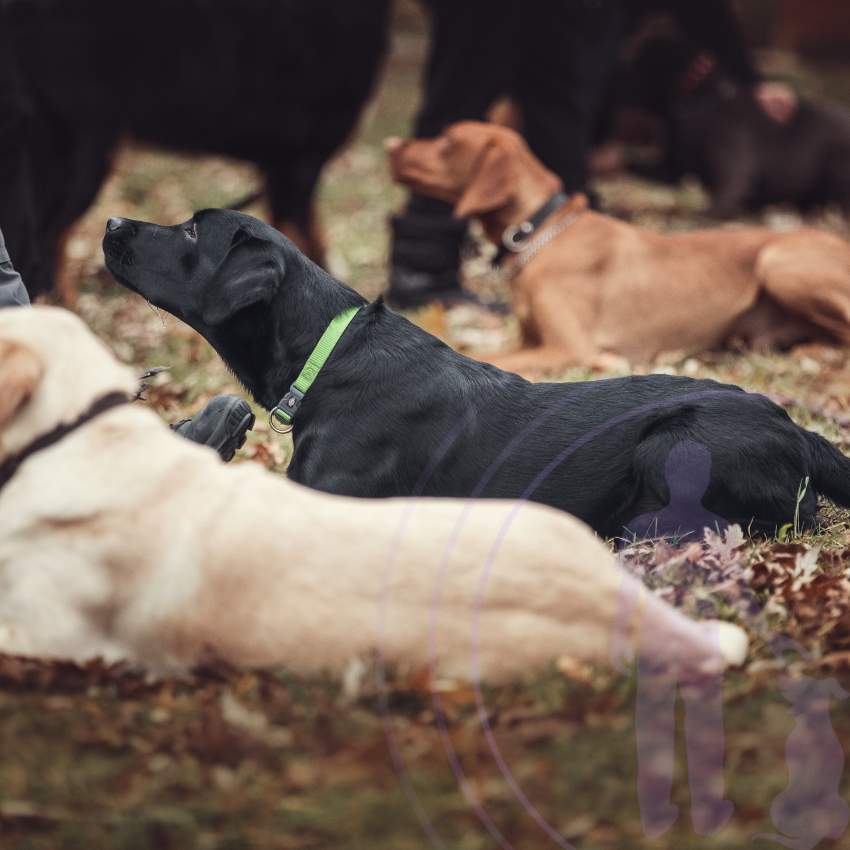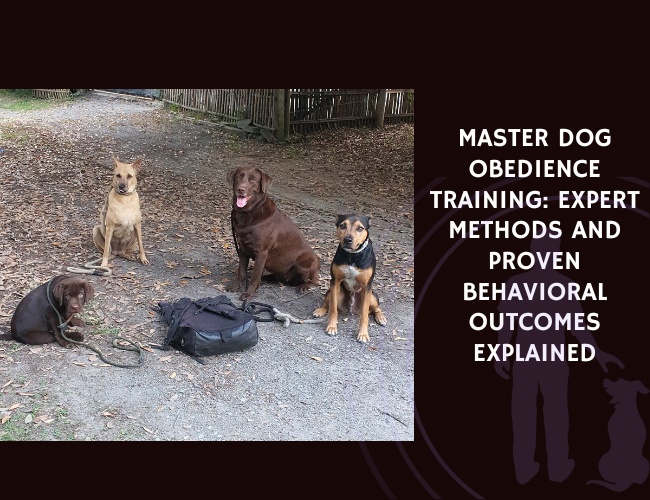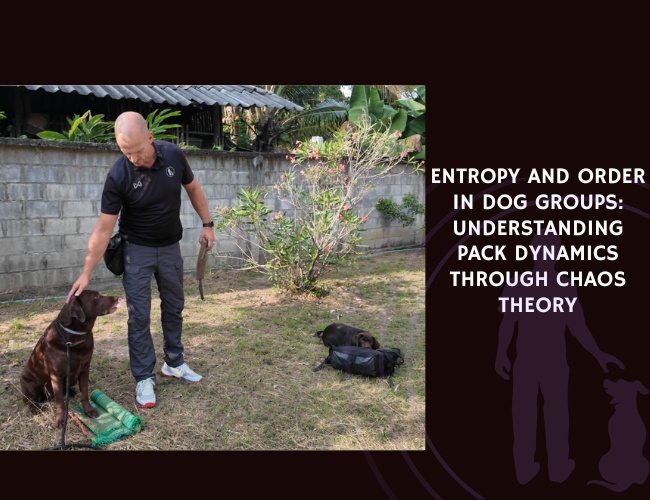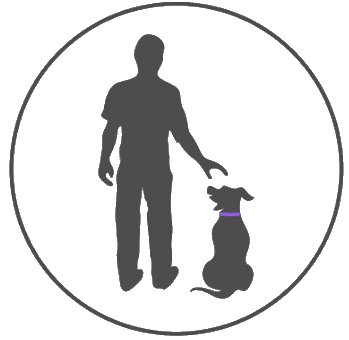Understanding the Fundamentals of Dog Obedience Training
Definition and Purpose of Dog Obedience Training
Dog obedience training encompasses teaching dogs to carry out behavioral commands and respond consistently to cues from their owner. The primary aim is to enhance communication between dogs and their owners, ensuring dogs can safely navigate various scenarios, socialize effectively, and adhere to a structured routine. This training is pivotal for improving both the dog’s and owner’s quality of life. By instilling fundamental commands, dog obedience training facilitates a harmonious relationship characterized by mutual understanding and respect.
Core Commands Every Dog Should Learn
Obedience training focuses on seven core commands that every dog should master:
- Sit: A fundamental command, ‘sit’ ensures that the dog remains stationary and calm.
- Stay: ‘Stay’ instructs the dog to remain in one place, enhancing their impulse control.
- Come: This command calls the dog to approach the owner, crucial for safety and recall.
- Heel: ‘Heel’ teaches the dog to walk beside the owner, mitigating leash pulling.
- Down: This command encourages the dog to lower their body, promoting relaxation and submission.
- Leave it: ‘Leave it’ directs the dog to ignore or release an object, crucial for managing curiosity and potential hazards.
- Recall: Effective recall training ensures the dog returns to the owner when called, enhancing safety in open spaces.
These commands collectively foster better behavior and interactive nuances between the dog and owner.
How Obedience Training Contributes to Safety, Socialization, and Daily Structure
Obedience training profoundly impacts a dog’s behavior, promoting safety, social skills, and daily structure:
- Safety: Well-trained dogs are less likely to engage in dangerous behaviors like running into traffic or reacting aggressively. Commands such as ‘come’ and ‘leave it’ are vital in preventing accidents and ensuring the dog’s well-being.
- Socialization: Training instills socially acceptable behaviors, allowing dogs to interact positively with other dogs and humans. This reduces anxiety and aggression, creating a more stable and enjoyable social environment for the dog.
- Daily Structure: Establishing a routine through obedience training provides predictability and security for dogs. Consistent practice of commands integrates structure into the dog’s day, reducing stress and ensuring adaptability to daily activities.
Understanding these fundamentals sets the foundation for exploring effective training methodologies, which will be covered in subsequent sections.
Exploring Different Training Methodologies
Positive Reinforcement Techniques
Positive reinforcement is one of the most widely endorsed methods in dog training, primarily because of its humane and effective nature. This method relies on rewarding desirable behaviors with treats, clickers, praise, or toys. It’s a simple concept: reward the behavior you want to see more of.
- Treats: High-value treats can be a powerful motivator for dogs. They help reinforce behaviors you want to encourage, such as sitting or staying.
- Clicker Training: This involves a small device that makes a clicking sound to mark the exact moment your dog performs the desired behavior, followed by a treat. Clicker training provides clarity to the dog on what specific action is being rewarded.
- Praise and Toys: Verbal praise and toys can also be effective rewards. Some dogs respond exceptionally well to a favorite toy or enthusiastic verbal praise.
Positive reinforcement builds trust and strengthens the bond between dogs and their owners. It fosters an environment where dogs are eager to learn and perform behaviors that garner rewards.
Balanced Training Approaches
Balanced training combines positive reinforcement with corrections. While proponents believe it offers a comprehensive training solution, it’s important to approach this method ethically.
- Rewards with Corrections: Positive behaviors are rewarded similarly to strict positive reinforcement techniques. However, unwanted behaviors may be corrected with a gentle nudge or a firm voice command.
- Ethical Considerations: The key to balanced training is ensuring corrections are humane and never cause fear or pain. This approach requires careful monitoring to avoid crossing into aversive territory.
While balanced training can be effective, ethical implications and the potential for misuse make it essential to implement it with caution and always prioritize the well-being of the dog.
Aversive/Compulsion-Based Methods
Aversive or compulsion-based training relies on corrections and force. This method often stems from outdated dominance theories and involves techniques such as leash jerks, e-collars, and physical corrections.
- Limitations and Criticisms: Research indicates that these methods can lead to fear, stress, and even aggressive behavior in dogs. For instance, studies raise concerns over e-collars and their impact on canine welfare, suggesting more humane methods should be prioritized.
- Potential Negative Consequences: Besides causing distress, aversive methods can damage the human-animal bond, leading to a lack of trust and joy in the training process.
Positive reinforcement remains the superior method for fostering happy, confident, and well-adjusted dogs. Balanced training might work with ethical vigilance, while aversive methods should generally be avoided due to their potential harm.
By understanding these training methodologies, you can make informed decisions that best suit your dog’s needs and help build a positive and productive training environment.
The Science Behind Positive Reinforcement
How Positive Reinforcement Builds Trust and Strengthens the Human-Animal Bond
Positive reinforcement is a training methodology rooted in behavioral science. It focuses on rewarding desirable behaviors to encourage their repetition. When implemented effectively, positive reinforcement can significantly enhance the bond between dogs and their owners.
Using rewards like treats, praise, and toys, trainers create a positive association with good behavior. Over time, dogs begin to understand that performing the desired action leads to a pleasurable outcome. This learning process builds trust and a sense of cooperation, enhancing the overall human-animal bond.
- Positive reinforcement helps dogs feel secure and understood.
- It promotes a stress-free learning environment.
- It encourages a consistent pattern of good behavior through positive associations.
Research Evidence Supporting Positive Reinforcement as the Most Effective and Humane Approach
The evidence supporting positive reinforcement is both extensive and compelling. Research consistently shows that reward-based training methods are highly effective in shaping desired behaviors in dogs. According to a study reviewed, positive reinforcement not only yields the best compliance from dogs but also enhances their emotional well-being.
Here are some key findings from the research:
- Positive reinforcement results in faster learning and behavior retention.
- Dogs trained using these methods exhibit fewer signs of stress and fear.
- The approach improves dogs’ social behaviors and adaptability in various environments.
This method stands in contrast to aversive or compulsion-based methods, which can cause fear, stress, and potentially aggressive behavior in dogs.
Practical Applications of Behavioral Science in Everyday Training Scenarios
Applying the principles of behavioral science involves consistent and clear communication with your dog. Here are practical steps for using positive reinforcement in everyday training:
- Start with Clear Commands: Ensure commands are simple and consistent. Use words like “sit” or “stay” in a calm, clear voice.
- Immediate Rewards: Reward your dog promptly after the desired behavior to reinforce the connection between the behavior and the reward.
- Use a Variety of Rewards: Different dogs respond to different rewards. Experiment with treats, toys, and verbal praise to find what motivates your dog the most.
- Consistency is Key: Ensure everyone in the household uses the same commands and rewards system to avoid confusing the dog.
- Gradual Progression: Start with basic commands in a distraction-free environment and gradually introduce more challenging scenarios as your dog improves.
Positive reinforcement can transform the training experience into an enjoyable and highly effective process for both you and your dog, leading to a harmonious and respectful relationship.
With a firm grasp on this training method, you are well-prepared to build a strong, positive relationship with your furry companion.

Cognitive and Behavioral Benefits of Proper Training
Development of Impulse Control, Focus, and Attention Span
Proper obedience training plays a crucial role in improving a dog’s cognitive abilities. One of the primary benefits is the development of impulse control. Dogs learn to resist their natural urge to react immediately and instead wait for a cue from their owner. This is particularly important in everyday scenarios such as waiting at a street corner or holding off on eating until given permission. Enhancing a dog’s impulse control can lead to a more composed and well-mannered pet.
Focus and attention span are also significantly improved through consistent training. Dogs trained regularly learn to concentrate better and are less likely to be distracted by external stimuli. This heightened focus is essential for effective communication between the dog and the owner, leading to more reliable responses to commands even in bustling environments.
Enhancement of Problem-Solving Abilities and Confidence Building
Engaging dogs in structured training sessions stimulates their cognitive functions and enhances problem-solving skills. When dogs are taught to understand and follow commands, they also learn to think critically and make decisions. This mental engagement boosts their confidence as they become more adept at navigating their environment and responding appropriately to various situations.
Training also helps build resilience in dogs. As they encounter different challenges during training and successfully overcome them, their self-assurance grows. This increased confidence can reduce anxiety and stress, making them more adaptable to new and unfamiliar settings.
Addressing Common Behavioral Issues
Proper training is instrumental in addressing and mitigating common behavioral issues such as excessive barking, jumping on people, and leash pulling. These behaviors, if left unchecked, can become problematic and lead to safety concerns. By incorporating specific commands and consistent training practices, owners can effectively manage and reduce these unwanted behaviors.
- Barking: Training commands like “quiet” or “leave it” can teach dogs to control unnecessary barking and only vocalize when appropriate.
- Jumping: Commands such as “off” or rewarding calm behavior can discourage dogs from jumping on people, thus promoting better social etiquette.
- Leash Pulling: Teaching a dog to “heel” ensures they walk calmly beside the owner, reducing the risk of accidents and making walks more enjoyable for both.
These behavioral improvements not only make daily life more pleasant but also contribute to the overall safety and well-being of both the dog and those around them.
Transition
Understanding the cognitive and behavioral benefits of training highlights the importance of age-appropriate strategies to maximize learning and adaptation. This leads us to explore how to tailor training approaches to different stages of a dog’s life, ensuring optimal outcomes and continued progress.
Age-Appropriate Training Strategies
When it comes to dog obedience training, one size does not fit all. Dogs’ learning capabilities and behaviors evolve as they age, requiring tailored training strategies to fit their developmental stage. This chapter will delve into the specifics of training puppies, adolescent dogs, and adult or senior dogs.
Puppy Training
Puppyhood is a critical period for canine development. During this time, puppies are highly receptive to new experiences, making it an ideal window for introducing basic obedience commands and socialization.
- Capitalizing on Critical Learning Periods:
- Puppies go through sensitive periods where they are more open to learning and forming social bonds. These periods typically occur between 8 to 16 weeks of age.
- Introducing core commands like “sit,” “stay,” and “come” during these sensitive periods ensures that these behaviors become deeply ingrained.
- Early Socialization:
- Exposing puppies to various environments, people, and other animals in a controlled manner helps them become well-adjusted adults.
- Positive social interactions during puppyhood can prevent fear-related behaviors and anxiety in adulthood.
Adolescent Dog Training
Training adolescent dogs, often referred to as teenage canines, can be challenging due to their changing behavior. These dogs are testing boundaries and may exhibit stubborn or rebellious tendencies.
- Adapting Methods for Changing Behavior:
- Consistency is key. Maintaining a regular training schedule helps provide structure and reinforces desired behaviors.
- Adolescents might need more mental stimulation and physical activity to curb unwanted behaviors like excessive barking or leash pulling. Including fun activities, such as fetch or agility exercises, can keep them engaged.
- Positive Reinforcement:
- Continue using positive reinforcement techniques, rewarding good behavior with treats, praise, or playtime, to reinforce the human-animal bond and encourage cooperation.
Adult and Senior Dog Training
No dog is too old to learn new tricks. Adult and senior dogs can benefit significantly from obedience training, which can improve their quality of life and address any long-standing behavioral issues.
- Benefits of Continued Training:
- Training helps to keep an older dog’s mind sharp, reduce stress, and increase their confidence.
- Using their well-established routines, training can successfully integrate new commands and behaviors.
- Proving Old Dogs Can Learn New Tricks:
- Patience and understanding are crucial. Adult dogs may take longer to adapt, but with gentle and consistent training, they can learn new commands and behaviors.
- Adapting training techniques to accommodate any physical limitations or health issues in senior dogs ensures a safe and supportive learning environment.
By addressing the unique needs of puppies, adolescents, and adult or senior dogs, training not only shapes well-behaved pets but also enriches their lives. Tailoring obedience training strategies to suit the developmental stages of dogs allows for optimal learning experiences.
Owner Consistency
Consistent training methods, timing, and clear communication from the owner are vital across all age categories. This consistency helps dogs understand expectations and achieve desired outcomes. Keeping training sessions positive and engaging ensures a lifelong commitment to obedience and good behavior.
Tailoring Training to Individual Dogs
How Breed Traits and Temperament Influence Training Approaches and Outcomes
When it comes to dog training, one-size-fits-all does not apply. Different breeds have varying traits that can influence how they learn and respond to training. For example, breeds such as Border Collies and Golden Retrievers are known for being eager to please and quick learners. Others, like the Basenji or Afghan Hound, might be more independent and challenging to train. Acknowledging these traits is crucial for effective training.
Training should be adapted to suit each dog’s temperament, energy levels, and intrinsic drives. High-energy breeds, like the Belgian Malinois, need more intense and frequent training sessions to stay engaged. On the other hand, more laid-back breeds might benefit from shorter, less frequent sessions. Understanding and acknowledging these breed-specific traits help in forming a training plan that is both effective and enjoyable for the dog.
Customizing Training Based on Energy Levels, Working Drives, and Personality Factors
Every dog has a unique personality that impacts how they respond to training. Some dogs might be very driven by food, while others may be more motivated by toys or praise. Customizing training methods to fit these motivational factors can greatly enhance training outcomes.
Dogs with high working drives, such as those in the sporting or herding groups, often require tasks that challenge both their minds and bodies. Agility training, advanced obedience, and job-related tasks such as search and rescue work well for these canines. Conversely, dogs with lower energy levels might excel in less physically demanding activities but can still benefit from obedience training that utilizes their specific interests and strengths.
The Importance of Owner Consistency, Timing, and Clear Communication
One of the cornerstones of successful dog training is consistency. Dogs thrive on routine and clear expectations. Consistent commands, rewards, and corrections help establish clear communication and reliability.
Timing is also critical. Immediate reinforcement—whether it’s praise, a treat, or a toy—helps dogs quickly associate their behavior with the reward. Delays can lead to confusion and slow learning progress. Additionally, maintaining a calm and authoritative tone of voice can significantly influence training effectiveness. Dogs are adept at reading body language, so owners should also be mindful of their gestures and posture during training sessions.
Finally, clear communication is essential. Dogs need to understand what is expected of them. Using clear, concise commands and ensuring that all family members use the same words and signals for behaviors helps the dog learn more efficiently and reduces confusion.
By understanding the unique traits and needs of individual dogs, tailoring training to their energy levels and personality, and maintaining clear consistency and communication, you can significantly enhance the training experience and results.

Choosing the Right Training Environment
Benefits and challenges of group obedience classes and social learning opportunities
Group obedience classes provide an excellent opportunity for dogs to interact and learn in a social setting. This environment fosters socialization skills, crucial for dogs to behave appropriately with other dogs and humans. Group classes can enhance a dog’s ability to focus amidst distractions, teaching them to respond to commands in varied environments.
However, group classes come with challenges. Dogs prone to being easily distracted or anxious might struggle in a group setting. The presence of other dogs can be both stimulating and overwhelming, potentially leading to reduced effectiveness in training. For such dogs, quieter environments may be more conducive to focused learning.
Advantages of private one-on-one or in-home training sessions for specific needs
Private one-on-one or in-home training sessions offer tailored approaches based on individual needs. These sessions are highly beneficial for dogs with specific behavioral issues, providing a calmer setting where the trainer can focus solely on the dog’s unique challenges. In-home training eliminates the stress of transporting the dog to a different location, making the process more comfortable and efficient.
Customization is a significant advantage of private sessions. Trainers can design personalized training plans addressing issues such as leash pulling, barking, or jumping. This focused approach can expedite progress and ensure that the dog receives the attention needed to overcome specific obstacles.
Selecting the appropriate environment based on your dog’s temperament and learning style
Choosing the right training environment involves understanding your dog’s temperament and learning style. High-energy dogs may thrive in group settings where they can expend energy and learn simultaneously. Conversely, shy or anxious dogs might benefit from the calm and security of one-on-one sessions.
Breed traits also play a role in determining the optimal training environment. For instance, breeds with a strong working drive, like Border Collies or Belgian Malinois, may excel in group classes that provide ample stimulation and challenge. On the other hand, breeds known for being more independent, such as Afghan Hounds, might require individualized attention to fully engage in the training process.
Ultimately, owner consistency, timing, and communication are paramount. Regardless of the chosen environment, clear communication and reinforcement of commands are essential for effective training. By recognizing and responding to your dog’s specific needs, you can select the most suitable training setting to foster their growth and development.
Maintaining a supportive and consistent approach ensures that training is both effective and enjoyable for your furry friend.
Finding Qualified Professional Help
Understanding Trainer Certifications and Qualifications
Hiring a qualified dog trainer is crucial for effective and humane obedience training. Certified trainers possess the knowledge and skills necessary to navigate various training methodologies, ensuring the best outcome for your dog. Some notable certifications to consider include:
- CPDT-KA (Certified Professional Dog Trainer – Knowledge Assessed): This certification evaluates a trainer’s knowledge in canine behavior and training techniques, ensuring they meet professional standards.
- IAABC (International Association of Animal Behavior Consultants): Trainers with IAABC certification have expertise in behavior modification and advanced training practices, specializing in behavior consulting.
- KPA CTP (Karen Pryor Academy Certified Training Partner): KPA CTP trainers are proficient in positive reinforcement methods, often utilizing clicker training, which is scientifically backed for its effectiveness and humane approach.
Questions to Ask When Selecting a Professional Dog Trainer
Choosing the right trainer involves thorough vetting to ensure they align with your training goals and the needs of your dog. Here are essential questions to ask:
- What is your training philosophy? Understanding whether they advocate for positive reinforcement, balanced methods, or aversive techniques will help you align with a humane approach.
- What certifications do you hold? Confirm their credentials to ensure they are well-qualified and knowledgeable.
- Can you provide references or testimonials? Speaking to past clients can offer insights into their effectiveness and approach.
- Do you continually educate yourself on the latest training methods? Trainers should stay updated with current best practices to ensure the most effective training.
- What is your experience with dogs similar to mine? Different breeds and temperaments may require varied approaches; ensure they have relevant experience.
Risks Associated with Hiring Unqualified Practitioners
Entrusting your dog to an unqualified trainer can lead to several risks:
- Ineffectiveness: Without proper training and knowledge, an unqualified trainer may fail to address your dog’s behavioral issues effectively.
- Ethical Concerns: They may employ outdated or harmful training methods, causing stress or fear in your dog.
- Safety Hazards: Improper techniques can lead to physical harm to your dog, worsening behavior instead of improving it.
- Lack of Progress: Without the correct methods and understanding, your dog may not only fail to progress but might develop new problematic behaviors.
Selecting a qualified, certified trainer is vital for ensuring that your dog is trained safely, effectively, and humanely. Investing in a professional with the right credentials and experience ultimately benefits both you and your dog, creating a harmonious and well-behaved pet.
Check for certifications and ask the right questions to ensure your dog trainer meets high standards, for long-term success and a positive training experience.
Maintaining Training Success Long-Term
Dog obedience training is not a one-time event but a continuous journey. A lifelong commitment to maintaining training success ensures your dog retains their skills and good behavior. Let’s dive into why ongoing practice, refreshers, and consistent reinforcement are crucial.
Lifelong Commitment to Training
Training your dog is a lifetime investment in their well-being and your harmonious relationship. Just like humans, dogs can forget what they’ve learned if there is no ongoing practice. Regular training sessions help reinforce commands and keep skills sharp, preventing your dog from slipping back into undesirable behaviors. It also provides mental stimulation, which is vital for a dog’s health and happiness.
Strategies for Refresher Training and Ongoing Practice
To keep your dog’s skills polished, consider the following strategies for refresher training and ongoing practice:
- Regular Short Sessions: Instead of long, infrequent training marathons, opt for short, regular sessions. Daily 10-minute sessions can be more effective and less tiring for your dog.
- Variety in Training: Mix up your training exercises to keep things interesting. Incorporate new commands and games that challenge your dog’s mind and body.
- Reward-Based Techniques: Continue using positive reinforcement, such as treats, praise, and toys, to encourage your dog. This sustains motivation and reinforces the desired behaviors.
- Real-Life Practice: Apply training commands in real-life situations to ensure your dog can respond appropriately in various contexts. Practice commands like “stay” at the park or “come” in a busy environment.
Preventing Regression
Preventing regression in your dog’s behavior requires consistent and ongoing efforts. Here are some tips to keep your dog’s training on track:
- Consistency is Key: Make sure everyone in the household uses the same commands and training methods. This prevents confusion and strengthens the dog’s understanding.
- Set Up for Success: Manage the environment to minimize distractions and potential triggers that could lead to unwanted behaviors. Gradually introduce more challenging scenarios as your dog progresses.
- Revisit Basic Commands: Regularly practice foundational commands like “sit,” “stay,” and “come.” These are the building blocks for more complex behaviors and help maintain your dog’s training.
Obedience training is a dynamic process that requires adaptation and ongoing engagement. By committing to lifelong training, incorporating refresher sessions, and applying consistent reinforcement, you lay the foundation for a well-behaved and happy dog. This proactive approach will ensure your dog’s continued success and your mutual enjoyment of a well-mannered companion.
Measuring Progress and Overcoming Challenges
Setting Realistic Expectations and Celebrating Training Milestones
Training your dog is a continuous journey that requires patience and realistic expectations. To foster a positive experience, start by setting achievable goals based on your dog’s current abilities and gradually increase the difficulty as progress is made. Recognize that each dog learns at their own pace, and it’s crucial to remain patient and celebrate even small successes.
- Establish clear, short-term goals to track progress.
- Use a milestone chart to note improvements in responding to commands.
- Celebrate achievements with treats, praise, and playtime.
Recognizing and celebrating these milestones helps to maintain motivation for both you and your dog, reinforcing the training efforts.
Troubleshooting Common Training Obstacles and Plateaus
Encountering obstacles and training plateaus is a normal part of the training process. When progress seems to stall, it’s important to identify the underlying cause and adjust your methods accordingly.
Common Training Obstacles
- Distractions:
- Gradually increase the level of distractions in your training environment.
- Start with low-distraction settings and validate commands before moving to more challenging environments.
- Inconsistency:
- Ensure all family members and caregivers use the same commands and techniques.
- Maintain consistent training sessions and routines.
- Lack of Motivation:
- Identify your dog’s preferred rewards and increase their desirability.
- Introduce variety into training sessions to keep your dog engaged.
Addressing Plateaus
If your dog hits a plateau, consider revisiting earlier, simpler commands to rebuild confidence. Gradually reintroduce more complex tasks once your dog demonstrates consistent success with foundational commands. Patience and persistence are key.
When to Seek Additional Support for Persistent Behavioral Issues
Sometimes, specific behavioral issues may persist despite your best efforts. In such cases, seeking professional help can make a significant difference. A qualified dog trainer or behaviorist can provide specialized techniques and insights tailored to your dog’s needs.
- Look for certified professionals (e.g., CPDT-KA, IAABC, KPA CTP) to ensure they possess the necessary expertise.
- Professionals can identify and address deep-seated behavioral issues using advanced methods.
- Ongoing support and tailored advice from experts can provide long-term solutions to persistent problems.
Dog training is a collaborative endeavor that sometimes requires external support. Don’t hesitate to reach out to qualified professionals to optimize your training experience. Remember, this journey benefits immensely from the consistent application of positive, humane techniques, fostering a lifelong bond built on trust and mutual understanding.










